The iPhone 7 and iPhone 7 Plus Review: Iterating on a Flagship
by Joshua Ho & Brandon Chester on October 10, 2016 8:00 AM EST- Posted in
- Smartphones
- Apple
- Mobile
- iOS
- iOS 10
- iPhone 7
- iPhone 7 Plus
System Performance
Section by Brandon Chester
At the heart of a smartphone lies the SoC. While there's now an increasingly common belief that specifications don't matter, the truth of the matter is that almost all of the software features that users now take for granted in a smartphone have only been made possible by the continued improvements in hardware performance. Modern smartphones with high resolution displays and complex interfaces would not exist if the available CPU and GPU processing power hadn't advanced as much as it has. On top of that, performance is something of a gating factor for software development, as the innovation that happens in software has to happen within the boundaries of what can be done with the hardware. Specifications in a smartphone actually matter quite a lot, even if the user isn't actively aware of all the individual components that make up their smartphone's SoC.
With the iPhone 7 Apple doesn't have the benefit of a new major process node to help improve performance. Any improvements will be the result of architectural improvements, as well as improvements that have been made to TSMC's 16nm process since the release of the Apple A9, which was Apple's first FinFET SoC. It's important to note that one of the goals of A10 Fusion is improving dynamic range, so the focus isn't solely on improving performance. However, device performance seemingly must improve with each generation, and Apple is advertising a 40% improvement in CPU performance and a 50% improvement in GPU performance with A10 Fusion compared to A9.
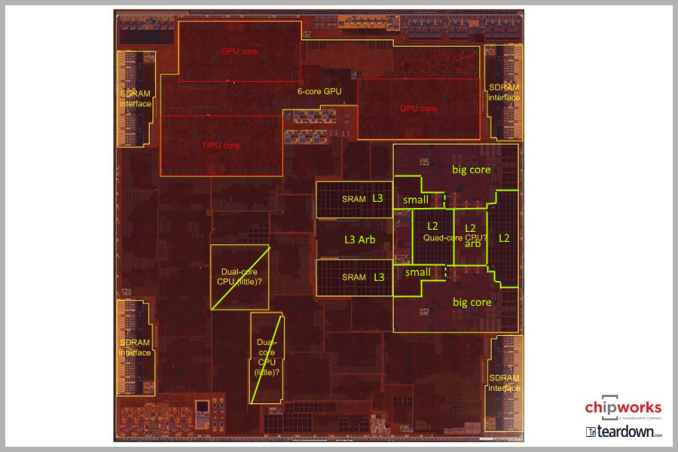
A10 Fusion's Floorplan (Special thanks to Chipworks)
While an in-depth look at A10 Fusion will have to wait until our seperate technology deep dive, we can still take a look at how performance has changed at a higher level. A10 Fusion's peak frequency is 2.3GHz, up from 1.8GHz on A9. This gives a theoretical improvement of 28% on its own, and the remainder will have to come from improvements to the architecture in Apple's (big) Hurricane cores. Based on our testing so far, Hurricane is not radically different from Twister (A9), but Apple has been making some optimizations. Meanwhile it should be noted that while A10 technically has four CPU cores – the two Hurricane cores and the two smaller cores – this is not a heterogeneous design, and only two cores are active at once. So for the purposes of high performance benchmarking, this means we're benchmarking the big cores nearly exclusively.
Anyhow, we've run our standard suite of benchmarks on the iPhone 7 and 7 Plus to see if A10 Fusion stands up Apple's performance claims.
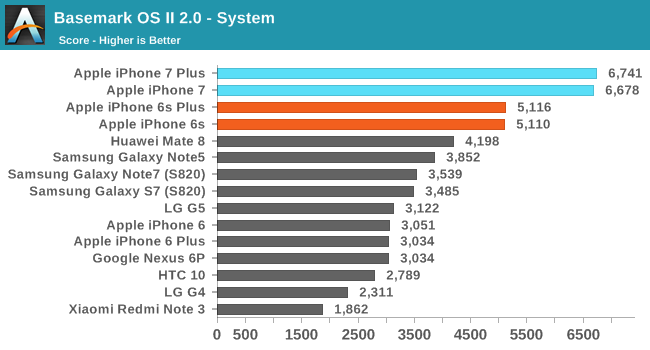
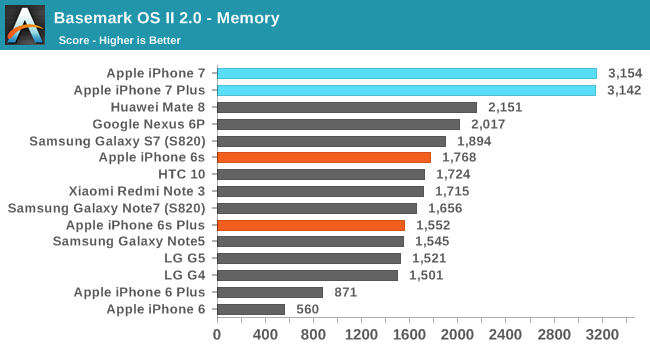
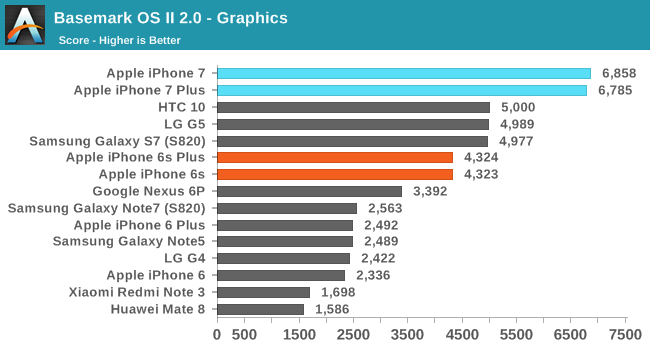
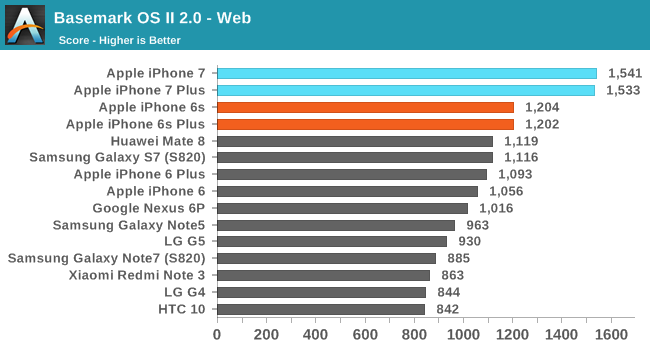

I've brought back BaseMark OS II for this review, although unfortunately the reason has less to do with wanting it back in the benchmark suite and more to do with there being very few cross-platform general system benchmarks nowadays. You can focus on the GPU, or the CPU, but the major system performance benchmark in mobile is PCMark and it remains exclusive to Android. BaseMark OS II is a pretty large optimization target now, and while it does test many aspects of the system it doesn't do so by directly simulating the tasks that a user would perform. Despite that, it helps in getting a holistic view of a device's performance by going beyond tests of a single component, so it's not without its uses.
The iPhone 6s and 6s Plus have remained the fastest overall devices in this test, so it's really just a matter of seeing how much Apple has improved. The latest generation of Android devices outpaced the GPU performance Apple's A9 SoC some time ago, so that's one area where Apple could stand to improve against the competition. As it turns out, they have. The iPhone 7 and 7 Plus show significant gains over their predecessors across the board. Performance in the system sub-test is up by 25-30%, and the graphics score is right in line with Apple's claimed 50% increase in performance. Web shows similar gains to system, which makes sense given that both are relatively CPU-bound.
The memory/storage test also shows a large improvement, which is interesting at first glance given that Apple didn't highlight any improvements in this area. However, this is just the result of the tested units being the 256GB model. On my retail iPhone 7 which is 128GB the memory score is essentially the same as the iPhone 6s which was also tested in a 128GB configuration. This comes down to the fact that these devices use a hybrid SLC/TLC storage solution, where the SLC storage can be used for writes and data can be moved later as needed. It's likely that on the 128GB iPhones the BaseMark OS II memory test is exceeding the size of the SLC cache, leading to lower scores based on the performance of the TLC NAND. On the 256GB iPhone the SLC cache is large enough to fit the entire data set used in the test, leading to a much higher score.
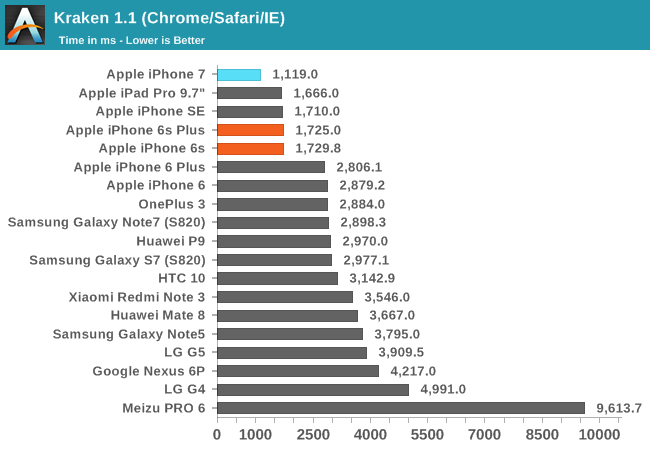
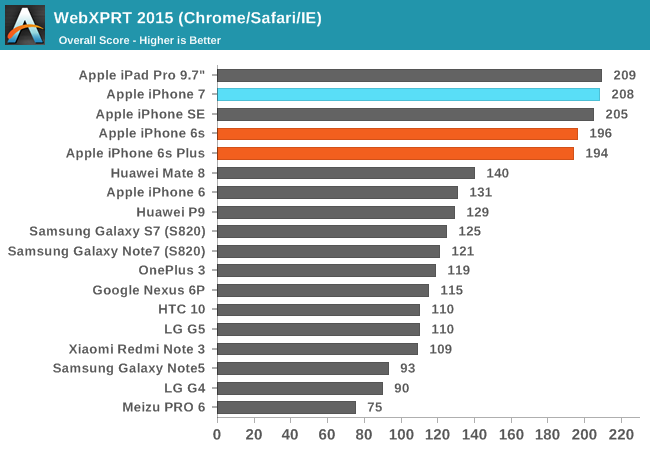
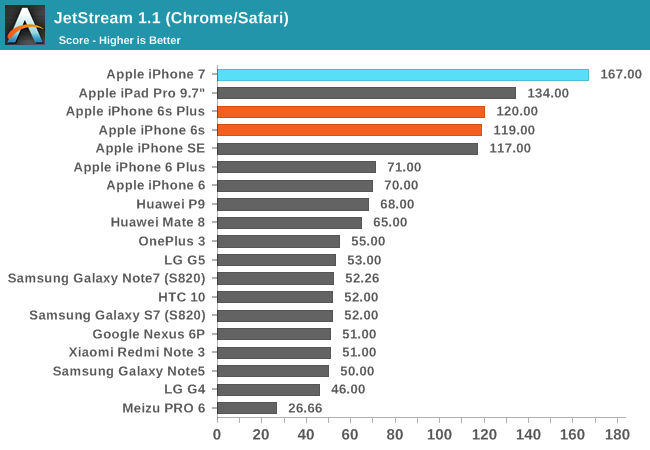
Web performance is an interesting case. While Apple's continued increases in single core CPU performance have benefited web performance with each generation, the truth is that improvements Mobile Safari's Nitro JavaScript engine have contributed a great deal as well. When looking at the charts you can see that there's a significant gap between the iPhone 7 and the next device, with the exception of WebXPRT where it's tied. What's more important than this gap is what the second device actually is. It's always another Apple device, and the same is true for the third device, and the fourth device, and so on. In Kraken and Jetstream the top seven devices on the chart are Apple's mobile devices, and the charts only have seven Apple devices in total. The Huawei Mate 8 is able to move ahead of the iPhone 6 in WebXPRT, but the gap between it and the iPhone 6s is still enormous. While Apple has continued to advance their web performance, it hasn't been with the immediate goal of beating the Android competition, as the best Android devices are still just trading blows with the iPhone 6.
WebXPRT is a small exception. As far as mobile benchmarks go, it's quite long and has short bursty workloads with pauses between each to simulate how a user would pause between different actions while using the browser. I suspect that in this case we're seeing the effects of A10 switching between its low power and high performance cores, causing parts of the test to be run on the little cores, which are not as performant. In fact, In the case of very quick actions that take only tenths or hundreths of a second to complete, it may not be possible to switch to the high performance cores before the operation has ended, causing the score to reflect the performance of the low power cores instead.
While it might seem reasonable to attribute the superior web performance of iOS devices to Apple's focus on improving single threaded CPU performance, the fact that Android devices with Cortex A72 CPUs are only matching Apple's A8 SoC shows that the gap is not only due to the CPU power available. Chrome's generally poor performance on Android is a significant limiting factor, and you can see in the chart how the improvement in Android device CPU performance over time has not translated into anything close to the sorts of gains that Apple has seen in the same period. While there are customized versions of Chromium like Snapdragon Browser that provide optimizations for a class of SoCs, it doesn't look like the gap between Android devices running Chrome and iOS devices running Mobile Safari is going to close any time soon, and if anything, it's only widening with each year.


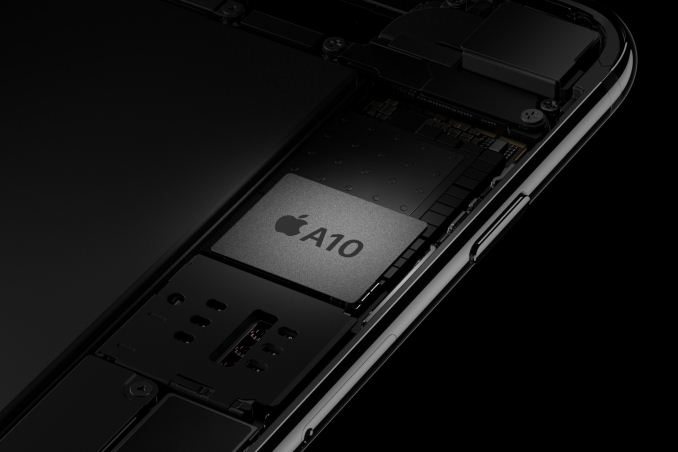








377 Comments
View All Comments
tuxRoller - Thursday, October 13, 2016 - link
Oh yes, AnTuTu. What does that do again? How does it do it?Geekbench is SLIGHTLY better as it explains, at a fairly high level, how each test is performed. It even lets you know that they are preference apple by using llvm everywhere.
None of these are worth respecting reporting on, however, unless the benchmarks are open source.
Ranger1065 - Wednesday, October 12, 2016 - link
The old Anandtech...maybe :)Dribble - Monday, October 10, 2016 - link
If you like your wireless headphones that's great, but don't try to sell me that ONLY having them is somehow fine. It's not like you couldn't use wireless for iphone 6 and now suddenly you can. Sometimes wired is better - e.g. phone in the car, you are charging phone and plugging into the jack to play music off it. You don't want to have to take some silly adaptor dongle everywhere with you in case you need wired (that's a bad user experience).It would also have been more honest to say why they removed it - it's not for some mythical extra space to add other stuff like you suggested, its 100% to make more $$$. Irrespective of who designs or makes it anything that plugs into apples proprietary jack has to pay apple money because they own the copyright. They don't own any copyright on the 3.5mm jack. Hence they removed the jack to force devices to use apples jack and hence pay them more money (something we the consumer end up paying for).
solipsism - Monday, October 10, 2016 - link
1) Cars with BT have been on the market for over a decade, it comes with inexpensive automobiles, and those buying a new iPhone 7 aren't likely to be driving a 1984 Toyota Tercel.2) If you're really against BT, and this is to be used while in the car, then why are carrying around this adapter? Wouldn't you just leave it in the car, which is now a single plug into the device, instead of two. If you claim that you wouldn't keep the adapter in the car, are you also saying that you're moving your USB and analog audio cables with you everywhere, too? If so, then what does it matter?
3) You don't even have to look at a teardown of the iPhone to see that internal volume makes a difference to what you can include inside a device. Physics still exit, right? Just look at the back of the iPhone to see that the camera is moved down. Then look at the camera, battery size gain, the better taptic motor, and the barometer, to name a few. If anything, I'd say this move is overdue, and you'll soon see this happen to to the rest of the smartphone market.
4) Apple doesn't own Bluetooth, so how does that argument fit into your 3.5mm jack copyright argument? I assume you know that over 15% of headphone unit sales were wireless last year and that it accounted for over 50% of the market. People typically don't like wires, yet, if you a huge fan of them you have so many options from using a stationary adapter in your car, to not buying a new iPhone, to not buying anything from Apple. Vote with your wallet.
Lolimaster - Monday, October 10, 2016 - link
His is not against bt, he against forced behavior and make the customer believe its the right choice, the future.What hes refering to, is that without the jack change, you had both options without hindering aesthetics and without make the device look stupid and retarded (which will make fashionistas wannabes buy the propietary haedphones), and also make sensible people annoyed by having a "dongle" to use their 3.5 headphones for no other reason but sucking more money out of monkeys/isheeps.
Dribble - Monday, October 10, 2016 - link
1) lots of cars don't have BT even those owned by apple users, it's generally an extra that you have to pay (too much!) for, it's also not as reliable as a solid jack connection.2) I am charging my iphone and playing music I can't plug in both at once. I am in someone else's car and want to share my music.
3) rubbish, the space taken by the jack was tiny, every other phone including all the previous iphones manages fine with a jack.
4) You have to remember to charge wireless headphones, and BT is never as reliable as it's meant to be, it gets confused, takes time to connect. A headphone jack doesn't have those problems, it just works all the time every time. Like I said I am pro having the option to use BT, in fact pretty well every phone on the market and all previous iphones support BT, yet a surprisingly large number of people still use wired - why is that?
grayson_carr - Monday, October 10, 2016 - link
My $19,000 Hyundai Elantra and my wife's similarly priced Honda Civic, both purchased in 2012, both came with bluetooth. And we didn't get the upgraded stereo systems or navigation or anything. If you bought a new car in the past 5 years and it didn't come with bluetooth, you must have really been scraping the bottom of the barrel. Also, I would like to know what car is so barebones?wolfemane - Tuesday, October 11, 2016 - link
Wife and I bought a uses 2002 Nissan Maxima 4 years ago and it had bluetooth... and a tape deck.I don't understand the hate people have towards the removal of the jack. And I wonder how many of those complaining are actual iphone users? I can't remember the last time I even used the headphone jack, been bluetooth for so long.. Personal, and anecdotal, but to the point.
oh and I have an iPhone 6s plus. First iPhone I've ever owned, came from a long line of Android phones (mainly Galaxy's). Gotta say, I dig it a lot more than my old S6.
Klug4Pres - Tuesday, October 11, 2016 - link
People like open standards, and solutions that are effective technologically.Wireless headphones might be "good enough" for many people, but consider that some have invested quite a lot of money in a superior, wired set of headphones. Yes, they can still use them with a dongle, but that is a "friction point" and causes problems with charging while listening to music.
Apple has done this to make money selling Airpods. Remember, it bought a purveyor of crappy headphones, and the company has to get a return on that investment.
This is an unsettling reminder that when buying many consumer electronic devices, we are beholden to companies who will position their products in such a way as to maximize their profits, and not in such a way as to give the best possible value to consumers.
Yes, I know, we can choose to buy or not buy etc. That is what critics are saying - they won't buy, or they will, but reluctantly. Markets do not always provide what people would like to buy. In the smartphone industry, Apple has significant market power, and knows how to milk the consumer (e.g. by drip-feeding features to boost unit replacement, RAM rationing, controling OS updates to break or cripple older phones etc., limiting repairability, sealed batteries, to name a few). On the other hand, a forced replacement cycle is what funds R&D, OS development, customer service, people with jobs at Apple, people with jobs in China, and so forth.
azulon1 - Thursday, October 13, 2016 - link
Look some of your stuff is a little over the line. I think the general argument is that they make their phones only as good as they must to defeat the competition. And I think that they are doing a fine job at it. For instance when you talk about ram rationing? Do they need to add more ram to defeat android headsets?